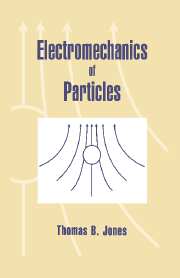Book contents
- Frontmatter
- Contents
- Preface
- Nomenclature
- 1 Introduction
- 2 Fundamentals
- 3 Dielectrophoresis and magnetophoresis
- 4 Particle rotation
- 5 Orientation of nonspherical particles
- 6 Theory of particle chains
- 7 Force interactions between particles
- Appendix A Analogies between electrostatic, conduction, and magnetostatic problems
- Appendix B Review of linear multipoles
- Appendix C Models for layered spherical particles
- Appendix D Transient response of ohmic dielectric sphere to a suddenly applied DC electric field
- Appendix E Relationship of DEP and ROT spectra
- Appendix F General multipolar theory
- Appendix G Induced effective moment of dielectric ellipsoid
- References
- Index
6 - Theory of particle chains
Published online by Cambridge University Press: 02 December 2009
- Frontmatter
- Contents
- Preface
- Nomenclature
- 1 Introduction
- 2 Fundamentals
- 3 Dielectrophoresis and magnetophoresis
- 4 Particle rotation
- 5 Orientation of nonspherical particles
- 6 Theory of particle chains
- 7 Force interactions between particles
- Appendix A Analogies between electrostatic, conduction, and magnetostatic problems
- Appendix B Review of linear multipoles
- Appendix C Models for layered spherical particles
- Appendix D Transient response of ohmic dielectric sphere to a suddenly applied DC electric field
- Appendix E Relationship of DEP and ROT spectra
- Appendix F General multipolar theory
- Appendix G Induced effective moment of dielectric ellipsoid
- References
- Index
Summary
Introduction to chaining and review of previous work
Closely spaced particles subjected to an electric or magnetic field interact electromechanically through the agency of their induced dipole and higher-order moments. Depending on the relative alignment of the particles, the mutual forces of interaction can be attractive or repulsive. In general, similar particles attract each other when aligned parallel to an applied field and repel each other when in perpendicular alignment. At close spacings, these interaction forces can become quite strong. There are two complementary physical interpretations of such interparticle electromechanics: one approach considers dipole–dipole interactions, while the other focuses upon the distortion of the applied field in the vicinity of each particle. The dipole–dipole interaction model stems from the “action-at-a-distance” physical interpretation of electrodynamics. Figure 6.1a shows two similar particles oriented with their line of centers parallel to the applied field. The induced dipoles clearly attract each other, irrespective of the sign of the Clausius–Mossotti function K (defined in Table A. 1 in Appendix A), just as do two permanent magnets when similarly aligned. On the other hand, when the particles are aligned perpendicular, as depicted in Figure 6.1b, they repel each other, again just as two permanent magnets aligned side by side would do.
The other interpretation of field-induced particle interactions focuses on the localized field disturbance caused by dielectric, conductive, or magnetic particles. For K > 0, the field is intensified near the poles and reduced near the equator. The reverse occurs when K < 0. Thus, the predicted particle interactions are consistent with those derived from consideration of dipole-dipole interactions.
- Type
- Chapter
- Information
- Electromechanics of Particles , pp. 139 - 180Publisher: Cambridge University PressPrint publication year: 1995
- 2
- Cited by



